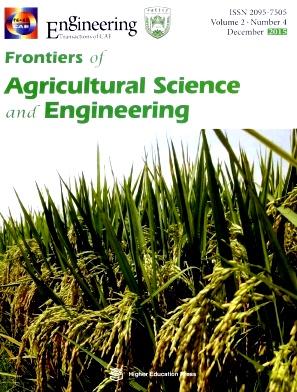PROTECTIVE ROLES OF D1 PROTEIN TURNOVER AND THE XANTHOPHYLL CYCLE IN TOMATO (SOLANUM LYCOPERSICUM) UNDER SUB-HIGH TEMPERATURE AND HIGH LIGHT STRESS
IF 2.8
4区 农林科学
Q1 AGRONOMY
引用次数: 3
Abstract
D1 protein turnover and the xanthophyll cycle (XC) are important photoprotective mechanisms in plants that operate under adverse conditions. Here, streptomycin sulfate (SM) and dithiothreitol (DTT) were used in tomato plants as inhibitors of D1 protein turnover and XC to elucidate their photoprotective impacts under sub-high temperature and high light conditions (HH, 35°C, 1000 µmol·m − 2 ·s − 1 ). SM and DTT treatments significantly reduced the net photosynthetic rate, apparent quantum efficiency, maximum photochemical efficiency, and potential activity of photosystem II, leading to photoinhibition and a decline in plant biomass under HH. The increase in reactive oxygen species levels resulted in thylakoid membrane lipid peroxidation. In addition, there were increased non-photochemical quenching and decreased chlorophyll pigments in SM and DTT application, causing an inhibition of D1 protein production at both transcriptional and translational levels. Overall, inhibition of D1 turnover caused greater photoinhibition than XC inhibition. Additionally, the recovery levels of most photosynthesis indicators in DTT-treated plants were higher than in SM-treated plants. These findings support the view that D1 turnover has a more important role than XC in photoprotection in tomato under HH conditions.亚高温强光胁迫下番茄d1蛋白周转和叶黄素循环的保护作用
D1蛋白周转和叶黄素循环(XC)是在不利条件下运行的植物的重要光保护机制。本文将硫酸链霉素(SM)和二硫苏糖醇(DTT)作为D1蛋白转换和XC的抑制剂用于番茄植株,以阐明它们在亚高温和强光条件下(HH,35°C,1000µmol·m−2·s−1)的光保护作用。SM和DTT处理显著降低了光系统II的净光合速率、表观量子效率、最大光化学效率和潜在活性,导致HH下的光抑制和植物生物量下降。活性氧水平的增加导致类囊体膜脂质过氧化。此外,在SM和DTT应用中,非光化学猝灭增加,叶绿素色素减少,在转录和翻译水平上抑制D1蛋白的产生。总的来说,D1周转的抑制比XC的抑制引起更大的光抑制。此外,DTT处理植物的大多数光合作用指标的恢复水平高于SM处理植物。这些发现支持了这样一种观点,即在HH条件下,D1周转在番茄的光保护中比XC更重要。
本文章由计算机程序翻译,如有差异,请以英文原文为准。
求助全文
约1分钟内获得全文
求助全文
来源期刊
CiteScore
5.10
自引率
2.70%
发文量
33
期刊介绍:
Frontiers of Agricultural Science and Engineering (FASE) is an international journal for research on agricultural science and engineering. The journal’s aim is to report advanced and innovative scientific proceedings in agricultural field including Crop Science, Agricultural Biotechnology, Horticulture, Plant Protection, Agricultural Engineering, Forestry Engineering, Agricultural Resources, Animal Husbandry and Veterinary Medicine, Applied Ecology, Forestry and Fisheries. FASE is committed to provide a high level scientific and professional forum for researchers worldwide to publish their original findings and to utilize these novel findings to benefit the society.

 求助内容:
求助内容: 应助结果提醒方式:
应助结果提醒方式:


